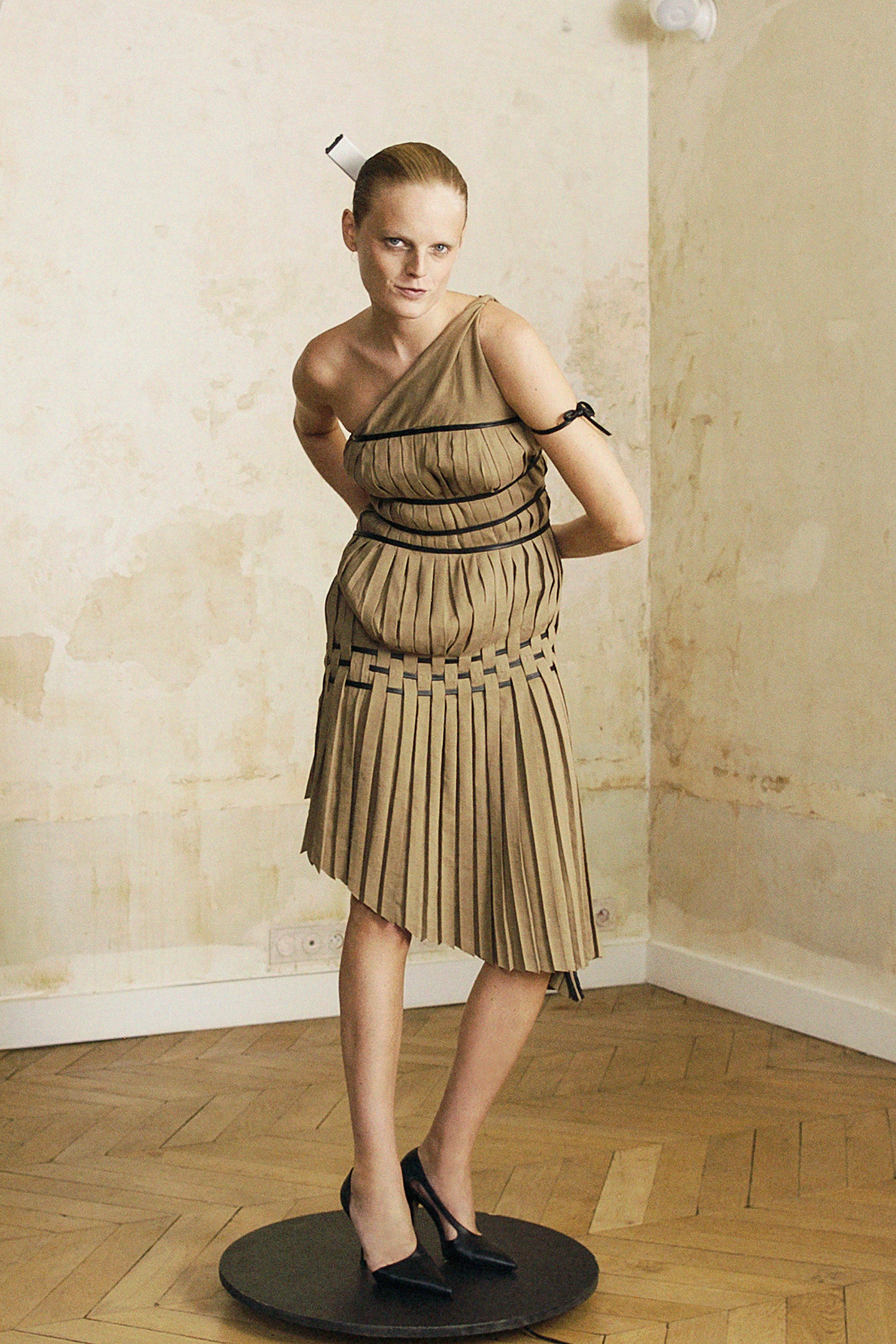
“Which designers do you most admire?” It’s a trite question, I admit—one that I often try to rephrase or avoid during interviews (responses are often pat or conventional). But right now, I’m genuinely interested. I’m on the phone with Canadian fashion designer Vejas Kruszewski, who founded his namesake label, Vejas, in 2014, at the age of 17. He’s an unusual designer and I feel sure his response will be intriguing. “I think the life story of [1930s couturier] Madame Grès is really interesting. Her dresses were inspired by ancient Greek statues, but they were so futuristic. Those streams of influence are fascinating. Actually, she also convinced [Cristóbal] Balenciaga to start his own line,” he tells me. “And I’m pretty sure the costume designer for the original Star Wars was looking at her work. I love those hypothetical links and the idea of a lineage of great people influencing great people.”
Kruszewski’s ability to identify the subtle, cobweb-like connections that span decades, visual mediums and a diverse cast of designers makes something light up in my mind. In a creative landscape and market that are besotted with pastiche (and horse-whipped by big business), it’s hard to remember what the sensation of seeing something new and unfamiliar feels like. We’re obsessed with novelty, but only if we can recognize it. As I listen to him talk about the way he engages with influences, I realize that his perspective is quite unique. An innate and unbridled sense of design often engenders this kind of vision. It’s also a requisite for making work that truly feels modern.
It might sound as though I’m making him out to be a romanticist, paying too much lip service to creative vision and not enough to the grueling day-to-day responsibilities that actually fuel a brand’s survival. But Kruszewski’s pragmatism is as remarkable as his artistry: while he muses on cross-pollination, he’s also got his eye trained on the fact that, first and foremost, he’s running a business. One could even say there’s something strangely serene about his acceptance of that side of the job; for him, it doesn’t seem as counterproductive to creative license as it does for some designers. When I ask what advice he’d give to fashion students, I’m not totally surprised by his response: “Research accounting!” He laughs and apologizes for the “boring” answer, but it’s quite valid.
Perhaps his matter-of-fact approach to both art and commerce is enabled by the simplicity of his clothing (deceptively simple, I should add). His signature consists of neutral-toned wardrobe staples—a leather jacket, a white t-shirt, the classic jean or little black dress—that have been subtly revised with such details as a reworked shoulder seam on a utilitarian jacket, or decorative paneling that reveals itself to be an unexpected pocket.
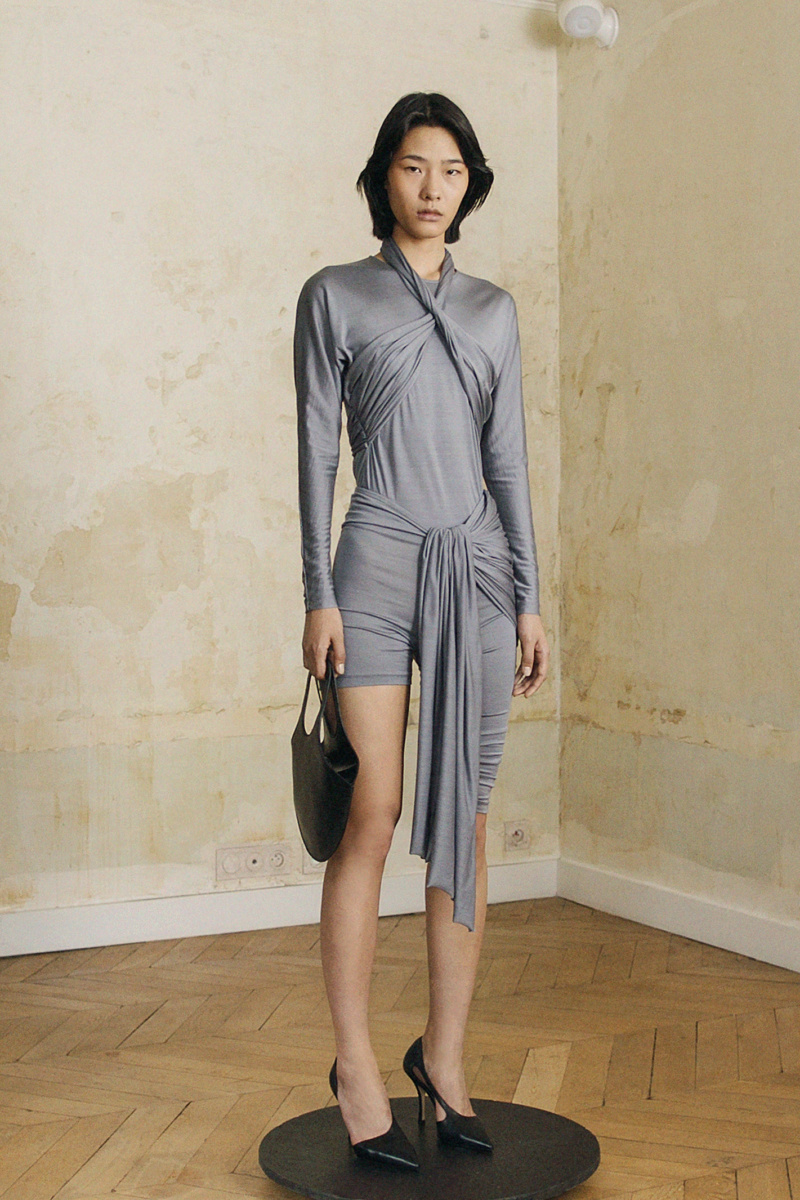
At one point in our interview, we’re talking about the famed 1940s costume designer Adrian, whose work greatly influenced Azzedine Alaïa. “Adrian was doing all these strange things with tailoring, like panels and inserts that were decorative but not frilly or feminine, more like masculine design elements. I love that there was a conversation between them, in some sense.” We talk a lot about movies during our call—Kruszewski is eager to design costumes for a film one day—and it’s intriguing to follow the connections he makes from one place to the next. “I swear I can see flecks of Adrian’s work in the Bladerunner costuming, all those sharp shoulders in the blazers that [the character] Rachel wears.” It feels telling that Kruszewski mentions so many films that take place in the future. “Costumes bring a lot to the plot, even in a movie like Alien. You could say that there’s not even much costuming in it, but there is, because it’s so deliberate.”
Understanding subtlety is a key factor in creating well-designed clothing, regardless of the style. But subtlety doesn’t seem to have much room in the current fashion zeitgeist. Jil Sander recently commented that fashion “has turned into a multimedia entertainment business where recognition and buzz decide the day. Accordingly, the silent language of a well-cut piece of clothing is no longer sufficient.” Designers such as Kruszewski are exceptions to this, but there aren’t many, and it’s certainly true that the expectation for brands to engage with the “entertainment” mentality can be stressful, if not crippling. “There’s a pressure to be really public as a way to build not only your visibility but also your business. You have to appear as though you’re always doing well—success after success. Talking about anything that doesn’t work out as planned causes a lot of fear and anxiety in this industry,” Kruszewski explains.
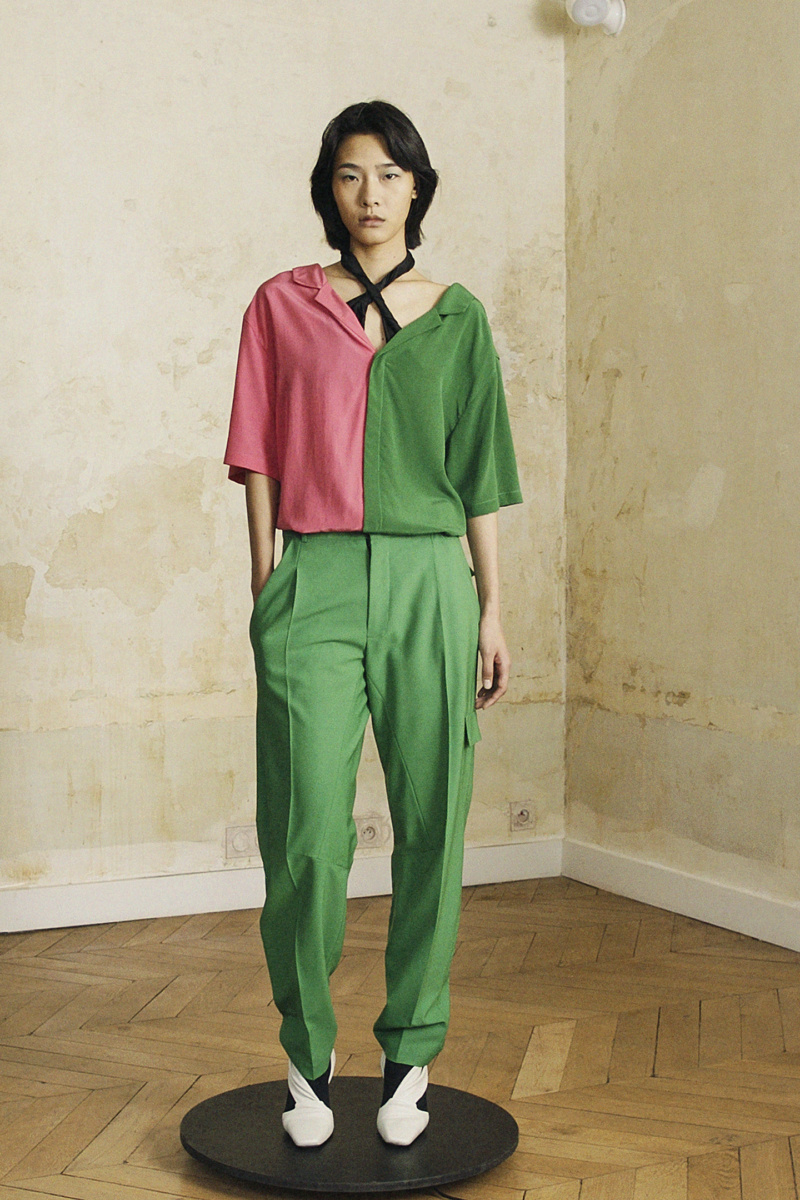
This pressure often lands young brands in deep water before they’ve figured out how to float. In 2017, Kruszewski and his two full-time colleagues (at the time, aged 21, 24 and 23, respectively) found themselves in a difficult position about a year after receiving the coveted LVMH Special Prize, one of the fashion industry’s most respected awards for young designers. The rewards included mentorship with the industry’s top creatives, as well as 150,000 euros (Kruszewski was 19 when he received the prize and the youngest designer ever to win). But such gifts can sometimes prove to be, unintentionally, something of a Trojan horse. The award secured their place in the global arena, but there were certain operational factors that made it difficult for the brand to fully harness the bounty of the prize. For one thing, they were still located in Canada. “LVMH gave a lot of visibility to the brand, and so did presenting the collections in Paris twice a year. We were producing in Italy, but we were still based in Canada, so there was a big issue about overstaying our visa in Europe.” Moving to Paris made a lot of sense, but the costs of such a move, and the logistical nightmare of obtaining visas, were prohibitive. “You can’t just take a month off to move, at least not if you’re following the seasonal schedule.”
Kruszewski decided to pause work on his own brand and accepted an offer to helm the Italian leather brand Pihakapi, for which he designed two exceptional collections. “A lot of people were surprised and disappointed. It looked as though we were going backwards, but it was actually in order to move into the future,” he tells me, pausing before he adds, “and to put ourselves in the right place.”
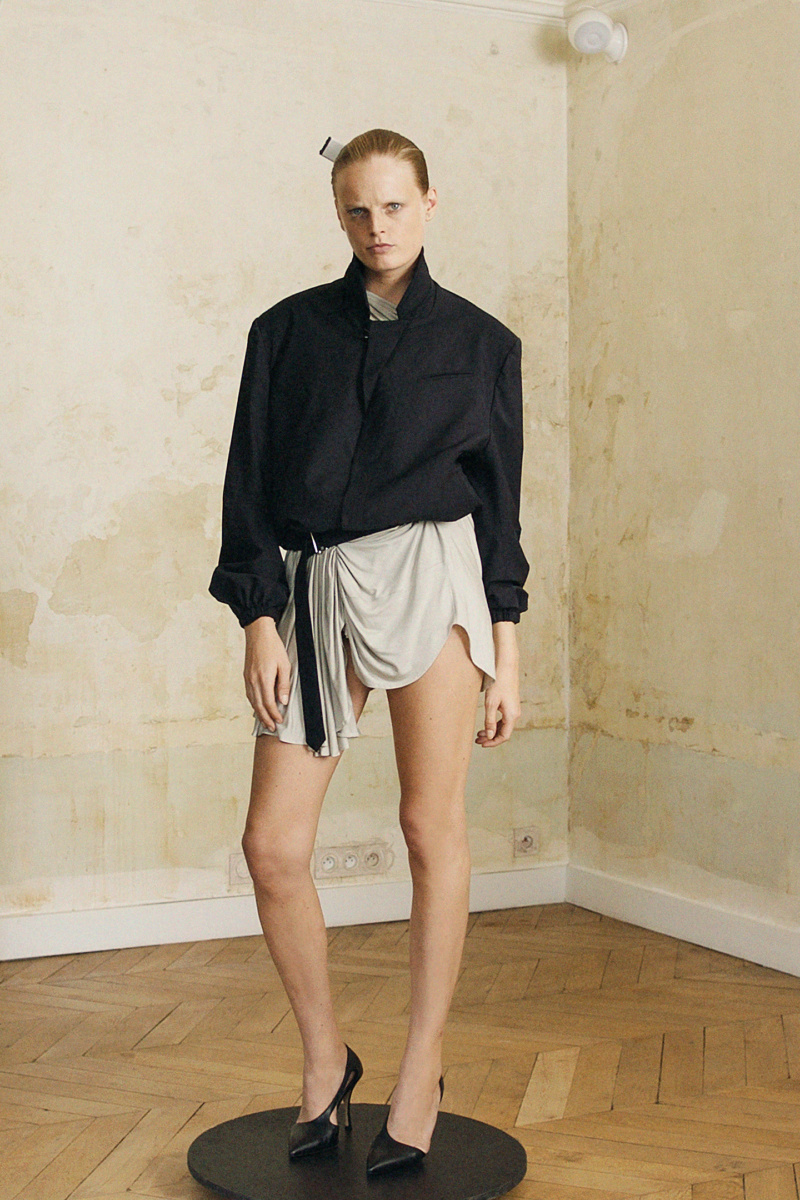
He seems to have seamlessly located that place earlier this year, when he returned to Vejas and presented the line’s Spring/Summer 2020 collection in Paris (he was finally able to make the move in 2018, while working for Pihakapi). The experience designing for another company served him well. “I learned how it feels to work for someone else, to be on the other end. It opened up my mind about how to delegate and how to communicate clearly and in an effective manner, in order to save everyone time and energy.” That Kruszewski is often described by journalists as pragmatic, mature and rational comes as little surprise. Another remarkable trait is the designer’s judicious ability to trust himself.
The SS 2020 collection presented an interesting shift towards a more sensual version of the Vejas silhouette, and incorporated some fruity shades of pink, green and yellow. Far from sexualized, the allure came rather from the thrill of the unexpected, or the mysterious, revealing itself. “There was this luscious, fertile vibe in terms of the colors. The yellow is very citrusy, and with the pink and green I was thinking of cactus fruit. When you cut it open, you never know what the inside is going to look like; it never matches the outside.”
Kruszewski also spent time at The Guimet Museum in Paris, which houses one of the largest collections of ancient Asian art in the world. He was particularly inspired by statuary from Thailand, India and Laos (spanning 3rd millennium BCE through 10th century CE). “I loved the lines of the fabric, the ropes and trims circling the stomach, legs and chest.” He blended those lines with the pleating techniques of Madame Grès’s dresses, which were, of course, also based on the raiment of ancient statuary. “I wanted to make a dress that had the same technique as hers but followed the more asymmetric lines that I saw on these statues: how they swept across the breast, over the back, onto the thigh.” Kruszewski’s work is a prime example of how technical referencing is very different from thematic referencing; it adheres to a design sensibility grounded in construction as opposed to exoticism. It also shows how a specific kind of copying is not only a positive thing, but a necessity for innovation. “There might be some element I like in a garment, but I can only focus on that one part, zoom in on it and combine it with something else.” That, in a nutshell, is the history of invention.
Many of the 20th century’s most celebrated designers stuck to a specific visual concept throughout most of their career. Today, such stylistic consistency between collections is often viewed as a lack of imagination, but those who think this way are missing the point. Madame Grès put it wisely: “As soon as you find something personal and unique, you must exploit it thoroughly and continue to implement it without stopping and right to the end. Similarly, you have to perfect your own technique and not let any detail escape or be neglected.” Sometimes it’s difficult to determine the pitch of a designer’s voice so early on in his career, but Kruszewski seems to have already discovered something deeply personal and unique in his vision and is well on his way towards cultivating it. He’s a rare breed, and most certainly one to keep your eye on.

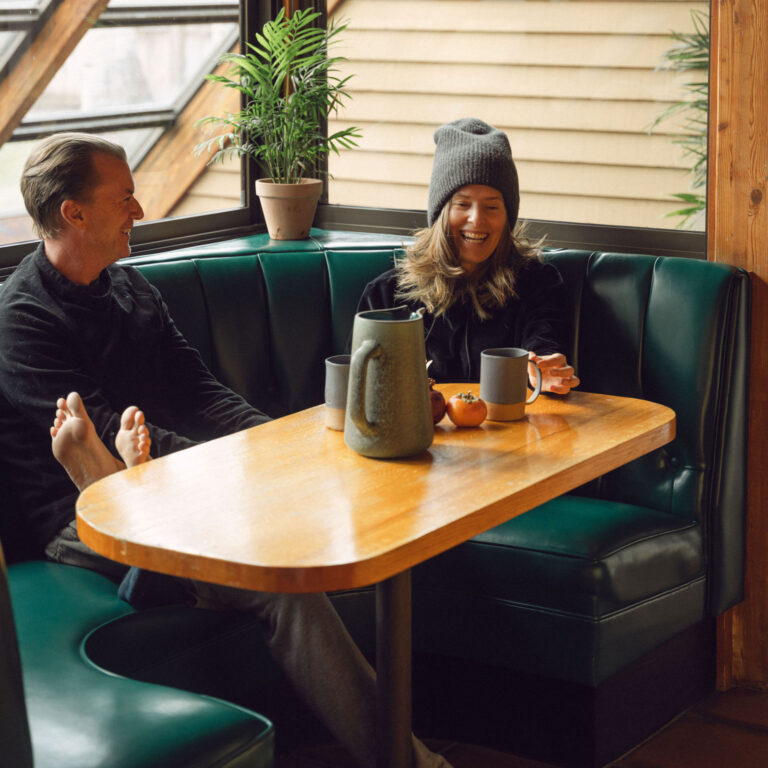








 in your life?
in your life?

